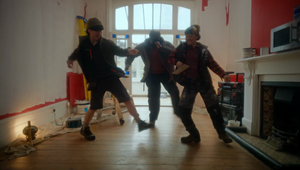
In 2021, Is ‘The Big Idea’ Enough?

How do you earn someone’s attention in 2021? For marketers, it’s quite the existential question. In a previous era, it used to be that a flagship TV ad would be enough to get people talking and start a cultural moment. Over the past decade or so, however, audiences have become fragmented and at times disparate in the channels they flock towards. Speaking to a large audience on a single channel has never been harder.
On top of that, the sheer volume of content marketers need to contend with is staggering. How can you hold your audience’s attention when a quality meme is never more than a scroll away? In times past, creatives used to hail ‘the big idea’ as a kind of holy grail, influencing hearts and minds and setting the agenda at the water cooler. Today, however, is a big idea really enough to cut through the noise?
To find out, we spoke to Five by Five Global’s creative directors Andy Mancuso and Ravi Beeharry, as well as senior strategic planner David Craft.
Digital Killed the TV Star?
Even in the chopped-up media landscape we inhabit today, TV still carries a certain prestige. It might not hit the audience numbers it saw in its heyday, but it remains a powerful cultural force. So, does a big idea communicated via TV still have the same magic in 2021?
“TV is still the credibility king in 2021, but there’s no doubt that as a platform it’s changed”, says David Craft. “It still gives you opportunities that other platforms don’t. That might be in terms of building credibility for your brand, expanding your reach, and appealing to a very diverse audience at the same time. There’s also the phenomenon of second screening, where people will be scrolling on their phones or a tablet at the same time as the TV is on in the background. What’s exciting for us is that we can come up with creative ways in which to engage audiences on both screens at the same time."
For creative duo Ravi and Andy, there’s a lot to be said about the psychological benefits of putting your brand ad on TV. “I think it goes back thousands of years in our DNA”, explains Andy. “Even when we were living in caves, you’d still come back and share stories around the hearth. That’s the same psychology that underpins TV today - I don’t think I’d ever see my teenage daughter were it not for TV in the evenings!”
“That’s spot-on, and you can see the echoes of that really clearly in TV today,” says David. “For example, how many old, maybe Edwardian-era houses have you seen in this country which have an old fireplace boarded up and a TV where that used to be? It’s no coincidence. It’s where we come together to share stories. From a marketing point of view, there will always be enormous value in that, no matter what other channels are out there”.
So perhaps rumours of TV’s death have been greatly exaggerated. “For me, I always think of that great philosopher Joey from Friends”, laughs Ravi. “If you don’t have a TV, what’s your furniture pointing at?!”
The Multi-Channel Matrix
When casting our minds back to the past, it’s often easy for nostalgia to cloud our judgement. Was it ever really the case, for example, that a TV ad would be enough to communicate a big idea, or have the best brand worlds always been built through multi-channel approaches?
“I think the best brand campaigns absolutely have always been multi-channel,” says David. “That might have been through a mixture of TV and OOH before social media arrived, but it was never left just to one channel to communicate an entire campaign. A good modern day example is John Lewis, who have made themselves part of the whole ritual of Christmas in the UK now. It’s always been a TV ad that communicates their big idea, which is quite old-fashioned in a certain sense. But the campaign itself is everywhere. Social, OOH, cinemas, and you can even get cuddly toys of whichever mascot is starring in the ad that year."
In an ideal world, then, would every campaign shoot out across multiple channels? “I don’t think so, no,” says Ravi. “The thing is that budgets are shrinking all the time, and you have to get great value out of whatever channel you’re on. So for some brands, TikTok just isn’t going to be right and that’s completely fine. Our job as creatives, together with David, is to figure out who our clients need to speak to and ensure we’re talking to them. That’s why you always want a multi-channel approach, but you don’t necessarily want to be on every channel under the sun if it’s not right for your brand."
“And the other thing to say on that,” notes Andy, “is that you always need to ensure your creative is adapted to fit the right channel. Not all channels are created equal, and you can’t copy and paste what works on one onto another. Some channels out there do have limitations, or there are cultural quirks that means messages might be read in a different way. For creatives, you need to be on top of that and make sure you’ve got the right plan for the right channel."
Attention Seekers
Contending with increasingly different channels is just one part of a modern marketer’s dilemma, however. Alongside the changing platforms, audiences are also finding that their attention is getting pulled in a thousand directions. No matter the channel, how can advertisers hope to be seen and remembered when there is so much else out there?
“On that point, I would go back to what we were saying about ‘the big idea’”, says Ravi. “A big idea can still hit like a sledgehammer and move us. The challenge lies in making sure they are adapted and communicated in the correct way, but there’s no doubt it’s still possible”.
So was it really easier in the ‘good old days’? “I think you could say it was easier in that you didn’t have to think about so many things. When there are only four or five channels on TV, you have a good idea of the format you’re going to be working in as soon as you start”, says Andy. “But you also have a lot more opportunities now. Brands which might previously not have been able to run a big TV campaign are now able to communicate with the people they need to speak to. There’s no doubt that’s a good thing.
“There’s nothing quite like the buzz you get when you know you’ve hit the nail on the head with a campaign. No matter what channels we’re talking about, that will never stop being magic.”













